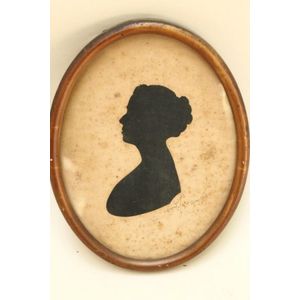Early 19th Century Bacchus Shell Cameo Portrait
Fine antique early 19th century oval portrait cameo, finely carved shell cameo of a Bacchus bust mounted on a slice of quartz on a deep green sea ground, framed in a ivory banded hardwood easel back frame, approx 11.5 cm high
You must be a subscriber, and be logged in to view price and dealer details.
Subscribe Now to view actual auction price for this item
When you subscribe, you have the option of setting the currency in which to display prices to $Au, $US, $NZ or Stg.
This item has been sold, and the description, image and price are for reference purposes only.
- Bacchus Motif - The Bacchus motif is a design that features the Roman god Bacchus, who is the god of wine, parties, and celebration. Bacchus is often depicted as a young man with long hair and a beard, holding a bunch of grapes or a wine cup. The Bacchus motif is often used in art and design as a symbol of abundance, revellery, and enjoyment. It can be found on a variety of decorative items, including glassware, ceramics, and other home decor items. The Bacchus motif represents the joy and celebration that can be found in social gatherings and the pleasures of good food and drink.
- Ivory - Ivory is a hard white material that comes from the tusks of elephants, mammoth, walrus and boar, or from the teeth of hippopotamus and whales. The ivory from the African elephant is the most prized source of ivory. Although the mammoth is extinct, tusks are still being unearthed in Russia and offered for sale.
Ivory has been used since the earliest times as a material for sculpture of small items, both in Europe and the east, principally China and Japan.
In Asia ivory has been carved for netsuke, seals, okimono, card cases, fan supports, animals and other figures and even as carved tusks.
In the last 200 years in Europe ivory has been used to carve figures, for elaborate tankards, snuff boxes, cane handles, embroidery and sewing accessories, in jewellery and as inlay on furniture. Its more practical uses include being used for billiard balls, buttons, and a veneers on the top of piano keys.
The use and trade of elephant ivory have become controversial because they have contributed to Due to the decline in elephant populations because of the trade in ivory, the Asian elephant was placed on Appendix One of the Convention on International Trade in Endangered Species (CITES), in 1975, and in January 1990, the African elephant was similarly listed. Under Appendix One, international trade in Asian or African elephant ivory between member countries is forbidden. Unlike trade in elephant tusks, trade in mammoth tusks is legal.
Since the invention of plastics, there have been many attempts to create an artificial ivory
This item has been included into following indexes:
-
brooches, design or type
- cameo 763
- portrait and locket 507
- brooches, set with - quartz 68
- cameos - freestanding carved shell cameos 47
Visually similar items

Framed Edwardian silhouette, in three quarter side profile, depicting a women with hair in bun, signed and dated 31st May 1913, 22 cm x 16.5 cm
Sold by
in
for
You can display prices in $Au, $US, $NZ or Stg.

Bronze Art Deco dish by Just Andersen of Denmark no. B61
Sold by
in
for
You can display prices in $Au, $US, $NZ or Stg.

Len Castle, bowl, impressed mark, 32 cm diameter
Sold by
in
for
You can display prices in $Au, $US, $NZ or Stg.

A Chinese celadon glaze shallow bowl, crackle glaze, with central medallion decoration. Private collection, Perth. Purchased V.M Antiques, Ermita, 25 cm
Sold by
in
for
You can display prices in $Au, $US, $NZ or Stg.
